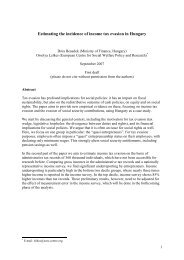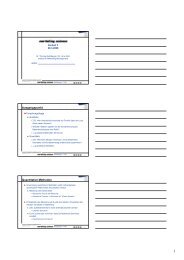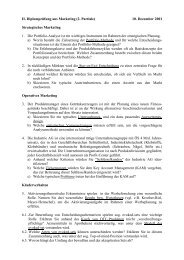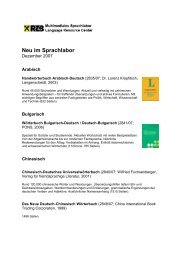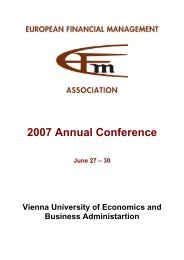Fund liquidation, self-selection and look-ahead bias in the hedge ...
Fund liquidation, self-selection and look-ahead bias in the hedge ...
Fund liquidation, self-selection and look-ahead bias in the hedge ...
Create successful ePaper yourself
Turn your PDF publications into a flip-book with our unique Google optimized e-Paper software.
If w 2,it<br />
implies <strong>look</strong>-<strong>ahead</strong> <strong>bias</strong> if w 1,it<br />
≠1<strong>and</strong> this is <strong>the</strong> case analyzed<br />
<strong>liquidation</strong><br />
Baquero, ter Horst <strong>and</strong> Verbeek (2005). In this paper, we disentangle<br />
by<br />
two sources of <strong>bias</strong> by identify<strong>in</strong>g both sets of weights <strong>and</strong> apply<strong>in</strong>g<br />
<strong>the</strong><br />
with one weight or <strong>the</strong>ir product. The correction for <strong>self</strong>-<strong>selection</strong><br />
corrections<br />
application of <strong>the</strong> above<br />
The<br />
weights allows us to determ<strong>in</strong>e to what extent we get different<br />
correction<br />
if we only correct for <strong>selection</strong> <strong>bias</strong> due to <strong>liquidation</strong>, assum<strong>in</strong>g<br />
results<br />
is r<strong>and</strong>om.<br />
<strong>self</strong>-<strong>selection</strong><br />
identify <strong>the</strong> weights (<strong>and</strong> to derive (8)) we need to assume that <strong>the</strong><br />
To<br />
do not depend upon future, potentially unobserved returns.<br />
probabilities<br />
we assume that <strong>self</strong>-<strong>selection</strong> <strong>and</strong> fund <strong>liquidation</strong> are mutually<br />
Fur<strong>the</strong>r,<br />
events, <strong>and</strong> both describe “absorb<strong>in</strong>g states”. That is, once a fund<br />
exclusive<br />
Then <strong>the</strong> denom<strong>in</strong>ator of w 1,it<br />
P {Y 1,it =1|Ω t ,z it } = (10)<br />
similarly for w 2,it . The right h<strong>and</strong> side probabilities are described by<br />
<strong>and</strong><br />
probit model <strong>in</strong> (3) provided <strong>the</strong> appropriate functional form (<strong>and</strong> con-<br />
<strong>the</strong><br />
variables) are chosen <strong>in</strong> x it . Consequently, consistent estimation<br />
dition<strong>in</strong>g<br />
<strong>the</strong> b<strong>in</strong>ary choice models for <strong>liquidation</strong> <strong>and</strong> <strong>self</strong>-<strong>selection</strong> allows us to<br />
of<br />
consistent estimators for <strong>the</strong> two sets of weights, which enables us<br />
obta<strong>in</strong><br />
correct for <strong>look</strong>-<strong>ahead</strong> <strong>bias</strong> due to <strong>the</strong>se two processes <strong>and</strong> separate <strong>the</strong>ir<br />
to<br />
Statistically, equation (9) also holds with <strong>the</strong> role of Y1,it <strong>and</strong> Y2,it reversed, so that<br />
8<br />
correction for <strong>liquidation</strong> <strong>bias</strong> would be conditional upon <strong>the</strong> fund not stopp<strong>in</strong>g re-<br />
<strong>the</strong><br />
Given that exist<strong>in</strong>g literature (Baquero, ter Horst <strong>and</strong> Verbeek, 2005) assumes<br />
port<strong>in</strong>g.<br />
is exogenous (w2,it =1), <strong>the</strong> most natural order<strong>in</strong>g is employed here.<br />
<strong>self</strong>-<strong>selection</strong><br />
(8) as<br />
{Y it<br />
=1|Ω t<br />
}<br />
P<br />
{Y it =1|Ω t ,z it } = (9)<br />
P<br />
w it<br />
=<br />
{Y 2,it<br />
=1|Ω t<br />
,Y 1,it<br />
=1}<br />
P<br />
{Y 2,it<br />
=1|Ω t<br />
,z it<br />
,Y 1,it<br />
=1} × P {Y 1,it<br />
=1|Ω t<br />
}<br />
P<br />
=<br />
P {Y 1,it<br />
=1|Ω t<br />
,z it<br />
}<br />
= w 2,it w 1,it .<br />
1for all i, t, <strong>the</strong>n <strong>self</strong>-<strong>selection</strong> is exogenous <strong>and</strong> does not lead<br />
=<br />
<strong>look</strong>-<strong>ahead</strong> <strong>bias</strong> <strong>in</strong> measures for performance (persistence). In this case,<br />
to<br />
is conditional upon <strong>the</strong> fund not liquidat<strong>in</strong>g. 8<br />
stops report<strong>in</strong>g to TASS, it will not return <strong>in</strong> <strong>the</strong> database at a later stage.<br />
can be determ<strong>in</strong>ed from <strong>the</strong> b<strong>in</strong>ary choice<br />
model as<br />
P {L i,t+1<br />
=1|r it<br />
,r i,t−1, ..., x i,t+1}...P {L i,t+s+1<br />
=1|r i,t+s,r i,t+s−1,...,x i,t+s+1}<br />
16



